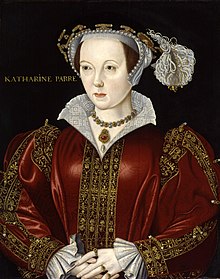
Back Catharina Parr Afrikaans كاثرين بار Arabic كاثرين بار ARZ Catalina Parr AST Yekaterina Parr Azerbaijani کاترین پار AZB Катрин Пар Bulgarian Katherine Parr Breton Katherine Parr BS Caterina Parr Catalan
| Catherine Parr | |
|---|---|
 Portrait by unknown artist in late 16th century, National Portrait Gallery | |
| Queen consort of England and Ireland | |
| Tenure | 12 July 1543 – 28 January 1547 |
| Born | c. August 1512[1] Blackfriars, London, England |
| Died | 5 September 1548[2] (aged 36) Sudeley Castle, Gloucestershire, England |
| Burial | 7 September 1548[3] St Mary's Chapel, Sudeley Castle |
| Spouses | |
| Issue | Mary Seymour |
| Father | Sir Thomas Parr |
| Mother | Maud Green |
| Religion | Protestant |
| Signature |  |
Catherine Parr (she signed her letters as Kateryn; 1512 – 5 September 1548[2][4]) was Queen of England and Ireland as the last of the six wives of King Henry VIII from their marriage on 12 July 1543 until Henry's death on 28 January 1547. Catherine was the final queen consort of the House of Tudor, and outlived Henry by a year and eight months. With four husbands, she is the most-married English queen. She was the first woman to publish in print an original work under her own name in England in the English language.[a][6]
Catherine enjoyed a close relationship with Henry's three children, Mary, Elizabeth and Edward. She was personally involved in the education of Elizabeth and Edward. She was influential in Henry's passing of the Third Succession Act in 1543 that restored his daughters Mary and Elizabeth to the line of succession to the throne.[7] Catherine was appointed regent from July to September 1544 while Henry was on a military campaign in France; in the event that he lost his life, she was to rule as regent until Edward came of age. However, he did not give her any function in government in his will. Following the king's death, she assumed the role of guardian to her stepdaughter, Elizabeth.
On 25 April 1544, Catherine published her first book, Psalms or Prayers, anonymously.[8] Her book Prayers or Meditations became the first original book published by an English queen under her own name on 2 June 1545. She published a third book, The Lamentation of a Sinner, on 5 November 1547. On account of her Protestant sympathies, she provoked the enmity of anti-Protestant officials, who sought to turn the king against her; a warrant for her arrest was drawn up, probably in the spring of 1546.[9] However, she and the king soon reconciled.
After Henry's death in 1547, Catherine was allowed to keep the queen's jewels and dresses as queen dowager. About six months after Henry's death, she married her fourth and final husband, Thomas Seymour, 1st Baron Seymour of Sudeley. Seymour was an uncle of King Edward VI (Catherine's stepson) and the younger brother of Lord Protector of England Edward Seymour, 1st Duke of Somerset, and of Jane Seymour, Henry's third wife. Catherine's fourth and final marriage was short-lived, for she died on 5 September 1548 due to complications of childbirth.[2][10] Her funeral was held on 7 September 1548[3] and was the first Protestant funeral in England, Scotland or Ireland to be held in English.[10]
- ^ James 2012, p. 18.
- ^ a b c James 2009, p. 294.
- ^ a b Mueller 2011, p. 182.
- ^ Catherine Parr's tomb at Sudeley Castle has a plaque that says her death date is 5 September 1548. The inscription comes from a lead plate that is on her coffin.
- ^ Baker 1994, p. 13.
- ^ Mueller, 2011, p. 1.
- ^ Jones 2010, p. 36.
- ^ Mueller 2011, p. 197.
- ^ Freeman, Thomas S. (2013). "One Survived: The Account of the Katherine Parr in Foxe's "Books of Martyrs"". In Betteridge, Thomas; Lipscomb, Suzannah (eds.). Henry VIII and the Court: Art, Politics and Performance. Farnham, UK: Ashgate. pp. 241–242.
- ^ a b Campbell, Sophie. "Sudeley Castle: the curious life and death of Katherine Parr", The Daily Telegraph. 14 August 2012. [1]
Cite error: There are <ref group=lower-alpha> tags or {{efn}} templates on this page, but the references will not show without a {{reflist|group=lower-alpha}} template or {{notelist}} template (see the help page).
© MMXXIII Rich X Search. We shall prevail. All rights reserved. Rich X Search